| Listing 1 - 10 of 13 | << page >> |
Sort by
|
Book
ISBN: 0123357209 9780123357205 Year: 1982 Publisher: London
Abstract | Keywords | Export | Availability | Bookmark
 Loading...
Loading...Choose an application
- Reference Manager
- EndNote
- RefWorks (Direct export to RefWorks)
Quantum mechanics. Quantumfield theory --- Quantum electrodynamics --- 530.19 --- Electrodynamics, Quantum --- QED (Physics) --- Quantum field theory --- Schwinger action principle --- Fundamental functions in general. Potential. Gradient. Intensity. Capacity etc. --- 530.19 Fundamental functions in general. Potential. Gradient. Intensity. Capacity etc. --- Fundamental functions in general. Potential. Gradient. Intensity. Capacity etc

ISBN: 069108775X 9780691037691 0691037698 9780691087757 Year: 1992 Publisher: Princeton : Princeton University Press,
Abstract | Keywords | Export | Availability | Bookmark
 Loading...
Loading...Choose an application
- Reference Manager
- EndNote
- RefWorks (Direct export to RefWorks)
This book is a systematic study of the classical and quantum theories of gauge systems. It starts with Dirac's analysis showing that gauge theories are constrained Hamiltonian systems. The classical foundations of BRST theory are then laid out with a review of the necessary concepts from homological algebra. Reducible gauge systems are discussed, and the relationship between BRST cohomology and gauge invariance is carefully explained. The authors then proceed to the canonical quantization of gauge systems, first without ghosts (reduced phase space quantization, Dirac method) and second in the BRST context (quantum BRST cohomology). The path integral is discussed next. The analysis covers indefinite metric systems, operator insertions, and Ward identities. The antifield formalism is also studied and its equivalence with canonical methods is derived. The examples of electromagnetism and abelian 2-form gauge fields are treated in detail.The book gives a general and unified treatment of the subject in a self-contained manner. Exercises are provided at the end of each chapter, and pedagogical examples are covered in the text.
Gauge fields (Physics) --- Quantum theory --- Champs de jauge (Physique) --- Théorie quantique --- 530.19 --- Quantum dynamics --- Quantum mechanics --- Quantum physics --- Physics --- Mechanics --- Thermodynamics --- Fields, Gauge (Physics) --- Gage fields (Physics) --- Gauge theories (Physics) --- Field theory (Physics) --- Group theory --- Symmetry (Physics) --- Fundamental functions in general. Potential. Gradient. Intensity. Capacity etc. --- Quantum theory. --- Gauge fields (Physics). --- 530.19 Fundamental functions in general. Potential. Gradient. Intensity. Capacity etc. --- Théorie quantique --- Fundamental functions in general. Potential. Gradient. Intensity. Capacity etc
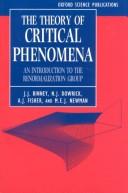
ISBN: 0198513941 0198513933 9780198513933 9780198513940 Year: 1992 Publisher: Oxford Clarendon
Abstract | Keywords | Export | Availability | Bookmark
 Loading...
Loading...Choose an application
- Reference Manager
- EndNote
- RefWorks (Direct export to RefWorks)
Statistical physics --- Critical phenomena (Physics) --- Mathematical physics --- Renormalization group --- Phénomène critique (Physique) --- Physique mathématique --- 536.75 --- 536.76 --- 530.19 --- Entropy. Statistical thermodynamics. Irreversible processes --- Relationships deduced from the two laws of thermodynamics. Phase transformations --- Fundamental functions in general. Potential. Gradient. Intensity. Capacity etc. --- Mathematical physics. --- Renormalization group. --- Critical phenomena (Physics). --- 530.19 Fundamental functions in general. Potential. Gradient. Intensity. Capacity etc. --- 536.76 Relationships deduced from the two laws of thermodynamics. Phase transformations --- 536.75 Entropy. Statistical thermodynamics. Irreversible processes --- Phénomène critique (Physique) --- Physique mathématique --- Group, Renormalization --- Quantum field theory --- Statistical mechanics --- Physical mathematics --- Physics --- Phenomena, Critical (Physics) --- Fundamental functions in general. Potential. Gradient. Intensity. Capacity etc --- Mathematics
Book
ISBN: 0201522535 9780201522532 Year: 1991 Volume: 82 Publisher: Wokingham, Don Mills, Ont. : Addison-Wesley,
Abstract | Keywords | Export | Availability | Bookmark
 Loading...
Loading...Choose an application
- Reference Manager
- EndNote
- RefWorks (Direct export to RefWorks)
Antiferromagnetism --- Antiferromagnetisme --- Haute température [Superconductivité à ] --- High Tc superconductivity --- High critical temperature superconductivity --- High temperature superconductivity --- Hoge temperatuur superconductiviteit --- Hubbard model --- Modèle d'Hubbard --- Superconductiviteit [Hoge temperatuur ] --- Superconductivité à haute température --- Temperatuur superconductiviteit [Hoge ] --- Température [Superconductivité à haute ] --- antiferromagnétisme --- 538.94 --- 530.19 --- Model, Hubbard --- Energy-band theory of solids --- Superconductivity --- Ferromagnetism --- Quantum liquids and solids --- Fundamental functions in general. Potential. Gradient. Intensity. Capacity etc. --- Antiferromagnetism. --- High temperature superconductivity. --- Hubbard model. --- 530.19 Fundamental functions in general. Potential. Gradient. Intensity. Capacity etc. --- 538.94 Quantum liquids and solids --- Fundamental functions in general. Potential. Gradient. Intensity. Capacity etc
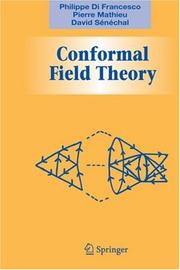
ISBN: 038794785X 9780387947853 1461274753 1461222567 Year: 1997 Publisher: New York : Springer,
Abstract | Keywords | Export | Availability | Bookmark
 Loading...
Loading...Choose an application
- Reference Manager
- EndNote
- RefWorks (Direct export to RefWorks)
Filling an important gap in the literature, this comprehensive text develops conformal field theory from first principles. The treatment is self-contained, pedagogical, and exhaustive, and includes a great deal of background material on quantum field theory, statistical mechanics, Lie algebras and affine Lie algebras. The many exercises, with a wide spectrum of difficulty and subjects, complement and in many cases extend the text. The text is thus not only an excellent tool for classroom teaching but also for individual study. Intended primarily for graduate students and researchers in theoretical high-energy physics, mathematical physics, condensed matter theory, statistical physics, the book will also be of interest in other areas of theoretical physics and mathematics. It will prepare the reader for original research in this very active field of theoretical and mathematical physics.
Conformal invariants. --- Quantum field theory. --- Invariants conformes --- Théorie quantique des champs --- Quantum field theory --- Conformal invariants --- 530.19 --- Relativistic quantum field theory --- Field theory (Physics) --- Quantum theory --- Relativity (Physics) --- Conformal invariance --- Invariants, Conformal --- Conformal mapping --- Functions of complex variables --- Fundamental functions in general. Potential. Gradient. Intensity. Capacity etc. --- 530.19 Fundamental functions in general. Potential. Gradient. Intensity. Capacity etc. --- Théorie quantique des champs --- Fundamental functions in general. Potential. Gradient. Intensity. Capacity etc --- Mathematical physics. --- Theoretical, Mathematical and Computational Physics. --- Physical mathematics --- Physics --- Mathematics
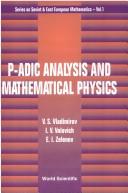
ISBN: 9810208804 9789810208806 Year: 1994 Volume: 1 Publisher: Singapore World scientific
Abstract | Keywords | Export | Availability | Bookmark
 Loading...
Loading...Choose an application
- Reference Manager
- EndNote
- RefWorks (Direct export to RefWorks)
P-adic analysis. --- Mathematical physics --- 51-7 --- 530.19 --- Mathematical studies and methods in other sciences. Scientific mathematics. Actuarial mathematics. Biometrics. Econometrics etc. --- Fundamental functions in general. Potential. Gradient. Intensity. Capacity etc. --- 530.19 Fundamental functions in general. Potential. Gradient. Intensity. Capacity etc. --- 51-7 Mathematical studies and methods in other sciences. Scientific mathematics. Actuarial mathematics. Biometrics. Econometrics etc. --- P-adic analysis --- Analysis, p-adic --- Algebra --- Calculus --- Geometry, Algebraic --- Physical mathematics --- Physics --- Mathematical studies and methods in other sciences. Scientific mathematics. Actuarial mathematics. Biometrics. Econometrics etc --- Fundamental functions in general. Potential. Gradient. Intensity. Capacity etc --- Mathematics
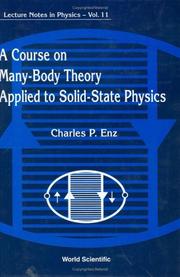
ISBN: 9971503379 9971503360 9789971503376 Year: 1992 Volume: 11 Publisher: Singapore World Scientific
Abstract | Keywords | Export | Availability | Bookmark
 Loading...
Loading...Choose an application
- Reference Manager
- EndNote
- RefWorks (Direct export to RefWorks)
Solid state physics. --- Many-body problem. --- 538.94 --- 530.19 --- 537.61 --- 538.93 --- Quantum liquids and solids --- Fundamental functions in general. Potential. Gradient. Intensity. Capacity etc. --- Theory of magnetism --- Transport processes (except in quantum liquids and solids) --- 538.93 Transport processes (except in quantum liquids and solids) --- 537.61 Theory of magnetism --- 530.19 Fundamental functions in general. Potential. Gradient. Intensity. Capacity etc. --- 538.94 Quantum liquids and solids --- Solid state physics --- Many-body problem --- Physics --- Solids --- n-body problem --- Problem of many bodies --- Problem of n-bodies --- Mechanics, Analytic --- Fundamental functions in general. Potential. Gradient. Intensity. Capacity etc --- Many body problem
Book
ISBN: 9780465020232 0465020232 0465028373 9780465028375 Year: 2010 Publisher: New York : Basic Books,
Abstract | Keywords | Export | Availability | Bookmark
 Loading...
Loading...Choose an application
- Reference Manager
- EndNote
- RefWorks (Direct export to RefWorks)
String theory says we live in a ten-dimensional universe, but that only four are accessible to our everyday senses. According to theorists, the missing six are curled up in bizarre structures known as Calabi-Yau manifolds. Here, Shing-Tung Yau, the man who mathematically proved that these manifolds exist, argues that not only is geometry fundamental to string theory, it is also fundamental to the very nature of our universe. Time and again, where Yau has gone, physics has followed. Now for the first time, readers will follow Yau's penetrating thinking on where we've been, and where mathematics will take us next. A fascinating exploration of a world we are only just beginning to grasp, The Shape of Inner Space will change the way we consider the universe on both its grandest and smallest scales.--From publisher description.
Hyperspace --- String models --- Fourth dimension --- Fourth dimension. --- Hyperspace. --- String models. --- Mathematics --- Physical Sciences & Mathematics --- Geometry --- 530.19 --- 512.7 --- Space of more than three dimensions --- Time travel --- Models, String --- String theory --- Nuclear reactions --- Algebraic configurations in hyperspace --- Geometry, Differential --- Geometry, Non-Euclidean --- Space and time --- Fundamental functions in general. Potential. Gradient. Intensity. Capacity etc. --- Algebraic geometry. Commutative rings and algebras --- Foundations --- 530.19 Fundamental functions in general. Potential. Gradient. Intensity. Capacity etc. --- 512.7 Algebraic geometry. Commutative rings and algebras --- Hyperespace --- Modèles des cordes vibrantes (Physique nucléaire) --- Quatrième dimension --- Modèles des cordes vibrantes (Physique nucléaire) --- Quatrième dimension --- Fundamental functions in general. Potential. Gradient. Intensity. Capacity etc
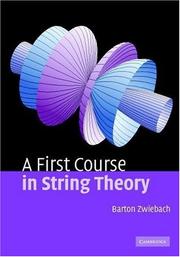
ISBN: 0521831431 9780521831437 9780511211157 0511211155 0511207573 9780511207570 9780511216527 0511216521 1283329255 9781283329255 0511211155 1107148472 051184168X 0511214731 9786613329257 1139130609 0511212925 Year: 2004 Publisher: Cambridge : Cambridge University Press,
Abstract | Keywords | Export | Availability | Bookmark
 Loading...
Loading...Choose an application
- Reference Manager
- EndNote
- RefWorks (Direct export to RefWorks)
An accessible introduction to string theory, this book provides a detailed and self-contained demonstration of the main concepts involved. The first part deals with basic ideas, reviewing special relativity and electromagnetism while introducing the concept of extra dimensions. D-branes and the classical dynamics of relativistic strings are discussed next, and the quantization of open and closed bosonic strings in the light-cone gauge, along with a brief introduction to superstrings. The second part begins with a detailed study of D-branes followed by string thermodynamics. It discusses possible physical applications, and covers T-duality of open and closed strings, electromagnetic fields on D-branes, Born-Infeld electrodynamics, covariant string quantization and string interactions. Primarily aimed as a textbook for advanced undergraduate and beginning graduate courses, it will also be ideal for a wide range of scientists and mathematicians who are curious about string theory.
String models --- Models, String --- String theory --- 530.19 --- Nuclear reactions --- 530.19 Fundamental functions in general. Potential. Gradient. Intensity. Capacity etc. --- Fundamental functions in general. Potential. Gradient. Intensity. Capacity etc. --- Fundamental functions in general. Potential. Gradient. Intensity. Capacity etc --- String models. --- Modèles des cordes vibrantes (Physique nucléaire) --- Quantum theory --- Modèles des cordes vibrantes (physique nucléaire) --- Théorie quantique --- Théorie quantique. --- Nuclear reactions. --- Nuclear transformations --- Nuclear transmutation --- Collisions (Nuclear physics) --- Compound nucleus --- Nuclear energy --- Nuclear physics --- Modèles des cordes vibrantes (physique nucléaire) --- Théorie quantique.
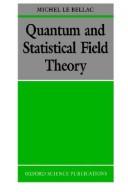
ISBN: 0198539290 0198539649 9780198539643 Year: 1995 Publisher: Oxford Clarendon
Abstract | Keywords | Export | Availability | Bookmark
 Loading...
Loading...Choose an application
- Reference Manager
- EndNote
- RefWorks (Direct export to RefWorks)
Quantum field theory. --- Statistical mechanics. --- Théorie quantique des champs --- Mécanique statistique --- Statistical physics --- Quantum mechanics. Quantumfield theory --- Quantum field theory --- 536.75 --- 530.19 --- Entropy. Statistical thermodynamics. Irreversible processes --- Fundamental functions in general. Potential. Gradient. Intensity. Capacity etc. --- 530.19 Fundamental functions in general. Potential. Gradient. Intensity. Capacity etc. --- 536.75 Entropy. Statistical thermodynamics. Irreversible processes --- Statistical mechanics --- Mechanics --- Mechanics, Analytic --- Quantum statistics --- Thermodynamics --- Relativistic quantum field theory --- Field theory (Physics) --- Quantum theory --- Relativity (Physics) --- Fundamental functions in general. Potential. Gradient. Intensity. Capacity etc
| Listing 1 - 10 of 13 | << page >> |
Sort by
|

 Search
Search Feedback
Feedback About UniCat
About UniCat  Help
Help News
News